Apple Valley, Minn.—Phyn, an Uponor joint venture, recently received one of the world’s most renowned, product-design awards on behalf of the Phyn Plus: Smart water assistant + shutoff. The company was honored along with the other prize recipients at the 2019 Red Dot Award Gala, held July 8 in Essen, Germany. More than 1,200 guests Read more
Uponor
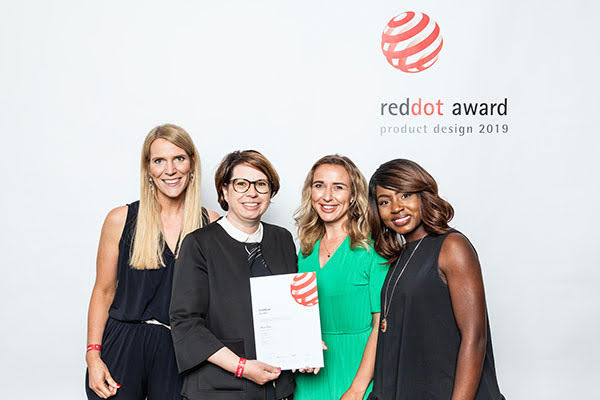
Left to Right: Michaela Frytag, Head of Corporate Communications- Construction Germany; Christine Schurz, Director of Brand Management Germany; Anastasiia Trubnikova, Senior Marketing Communications Specialist Germany; Laura Selana, Marketing Specialist Germany with the 2019 Red Dot Award for Phyn Plus.

Houston-based David Weekley Homes, the largest privately-held home builder in the U.S., announced today the winners of its annual Partners of Choice awards, and Uponor North America (Uponor) was recognized for the sixth year in a row — this year receiving an ‘AA’ ranking in quality and service. In its 15th year, the Partners of Choice awards Read more
Houston-based David Weekley Homes, the largest privately-held home builder in the U.S., announced today the winners of its annual Partners of Choice awards, and Uponor North America (Uponor) was recognized for the sixth year in a row — this year receiving an ‘AA’ ranking in quality and service.
 In its 15th year, the Partners of Choice awards recognize supplier-companies that participate in David Weekley Homes’ yearlong assessment-and-feedback program that sets consistently high industry standards and drives continuous improvement. Of the 200 companies assessed in the supplier-feedback platform, only six have won a Partners of Choice Award for the past six years.
In its 15th year, the Partners of Choice awards recognize supplier-companies that participate in David Weekley Homes’ yearlong assessment-and-feedback program that sets consistently high industry standards and drives continuous improvement. Of the 200 companies assessed in the supplier-feedback platform, only six have won a Partners of Choice Award for the past six years.
“Today’s home buyer is more informed and has higher expectations than ever before,” says John Schiegg, director of supply chain services for David Weekley Homes. “We will continue to rely on our strongest National Trading Partners to help us deliver a buying experience that is unsurpassed in the home building industry.”
Uponor began participating in the Partners of Choice assessment program in 2014. The program includes a customer portal unique to each supplier where companies can receive their feedback results for the current year as well as previous years to analyze and assess their progress.
“At David Weekley Homes, we set the highest of expectations for our team members and our National Trading Partners. Uponor continues to demonstrate world-class excellence and embraces our goal of providing a world-class building experience for our customers,” said Schiegg.
Since its inception in 2004, the Partners of Choice assessment program is continuing to set new industry standards for quality and process improvement, seeing an average increase of 13 percent each year in supplier engagement and progress.
“Uponor deeply values our long-standing partnership with David Weekley Homes,” said Carl Hines, national builder sales manager at Uponor North America. “The Partners of Choice assessment program is a great example of our ongoing efforts to enhance our customer experience. For Uponor to be one of a few participants recognized with this award for the past six years is an incredible honor for our company and employees.”
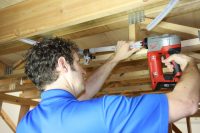
Residential plumbing and HVAC installers take note: you can pipe an entire home with the durability, flexibility and cost-effectiveness of PEX — for plumbing, fire sprinkler systems and radiant floor heating. Here’s how… PEX plumbing With more new homes plumbed with PEX than copper and CPVC combined, you’re probably already aware of the benefits of Read more
Residential plumbing and HVAC installers take note: you can pipe an entire home with the durability, flexibility and cost-effectiveness of PEX — for plumbing, fire sprinkler systems and radiant floor heating.
Here’s how…
PEX plumbing
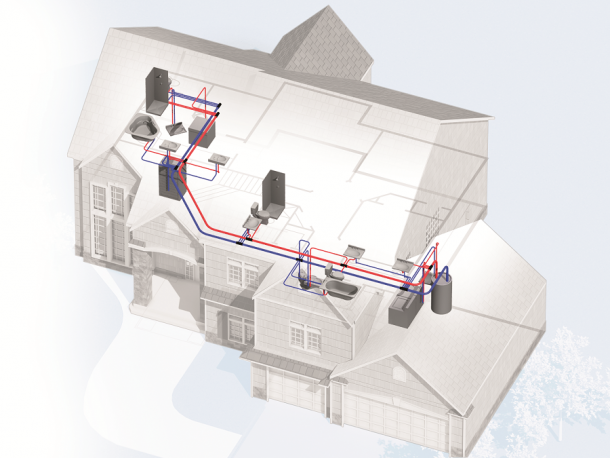 With more new homes plumbed with PEX than copper and CPVC combined, you’re probably already aware of the benefits of plumbing with PEX. However, you may not know about a newer, smarter way to install a PEX plumbing system that goes in faster, uses less materials, requires fewer connections and minimizes your liability.
With more new homes plumbed with PEX than copper and CPVC combined, you’re probably already aware of the benefits of plumbing with PEX. However, you may not know about a newer, smarter way to install a PEX plumbing system that goes in faster, uses less materials, requires fewer connections and minimizes your liability.
This innovative design is called Logic plumbing.
The Logic approach uses the flexibility of PEX pipe to minimize connections and reduce potential leak points while also incorporating multiport tees located near fixture groupings to limit the amount of pipe and connections needed.
What’s a multiport tee, you ask? It’s essentially a bunch of tees all molded together to create one long tee with multiple outlets. This design greatly reduces the number of fittings and connections needed to plumb a home (think: reduced materials cost and labor time).
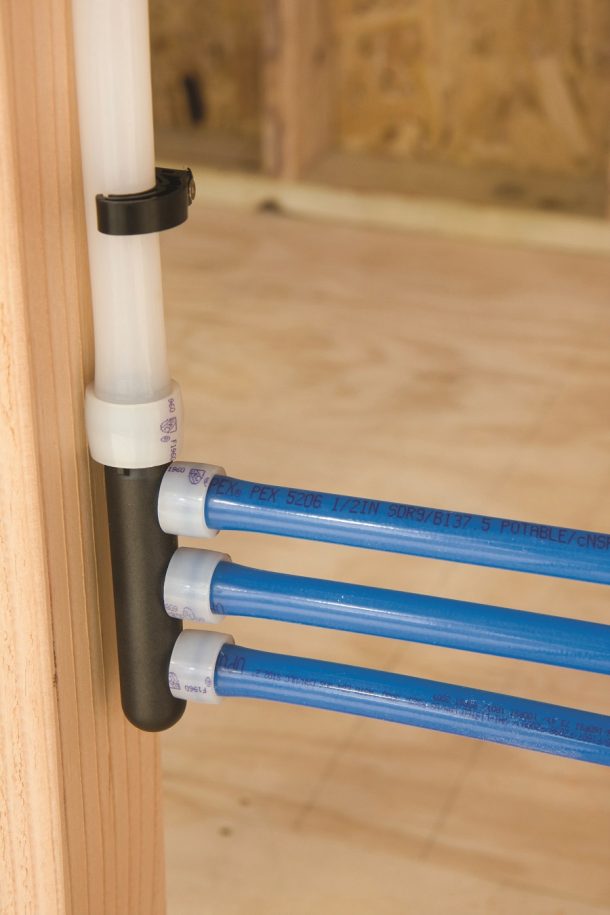 Here’s an example of how a multiport tee saves installation time and materials: a flow-through multiport tee with six outlets has eight connections (six connections for the ports, a main flow-through inlet and a main flow-through outlet). Six regular tees, on the other hand, have a whopping 18 connections. That’s an increase of more than double the connections — and double the installation time.
Here’s an example of how a multiport tee saves installation time and materials: a flow-through multiport tee with six outlets has eight connections (six connections for the ports, a main flow-through inlet and a main flow-through outlet). Six regular tees, on the other hand, have a whopping 18 connections. That’s an increase of more than double the connections — and double the installation time.
Best of all, multiport tees are not considered manifolds, so they can be installed behind walls without the need for an access panel. Double win, there!
For a Logic layout, a main line connects to a multiport tee with distribution lines going out from the multiport to provide water to all fixtures in a single or adjacent grouping. This design uses significantly less pipe than a home-run layout, with just a few more connections. Plus, it requires considerably fewer connections compared to a trunk-and-branch installation.
For example, a 2,300-square-foot, two-story home using a Logic design requires only 637 feet of pipe while a home-run system uses 1,515 feet of pipe. And, while it’s true a Logic installation uses slightly more connections than a home-run layout (59 vs. 48 in the 2,300-square-foot, two-story home example), the amount of pipe savings is significantly more beneficial with the labor and material savings you get with less pipe to install.
A Logic layout also installs much faster compared to a trunk-and-branch system due to the vast reduction in connections. With the two-story home example, a Logic layout uses a mere 16 fittings and 59 connections compared to a whopping 96 fittings and 165 connections for trunk and branch.
PEX multipurpose fire sprinkler systems
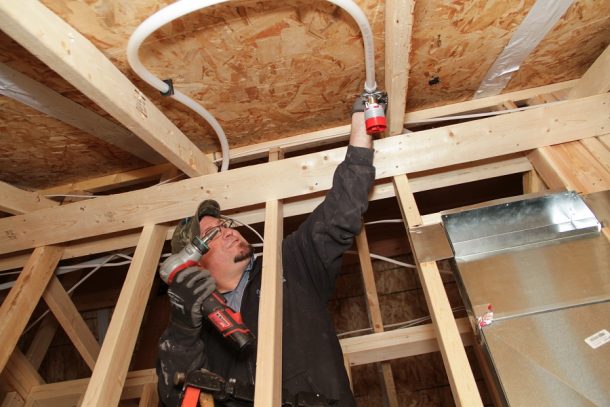 If you’re a licensed plumber who wants to add an additional service to your offering, check out PEX multipurpose fire sprinkler systems. These systems combine the fire sprinklers with a home’s cold-water plumbing. It’s genius!
If you’re a licensed plumber who wants to add an additional service to your offering, check out PEX multipurpose fire sprinkler systems. These systems combine the fire sprinklers with a home’s cold-water plumbing. It’s genius!
Installation is remarkably easy — the sprinkler is essentially just another fixture to tie into the plumbing line. For most contractors who already install PEX plumbing systems and have the tools, knowledge and, most importantly, the relationships with the home builders, this is a slam dunk.
Depending on the jurisdiction, multipurpose systems typically don’t need check valves or backflow preventers, and because they combine with the potable plumbing, they don’t use antifreeze, so all those added costs are eliminated.
To get started in most jurisdictions, licensed plumbers just need the appropriate training and a quality design that meets the NFPA 13D standard requirements for home fire sprinkler systems.
If you’re interested in learning more, email me at kim.bliss@uponor.com, and I can get you all the information you need to add this profitable new service to your business.
PEX hydronic radiant floor heating
There’s nothing like the comfort of radiant floor heating — ask anyone who has experienced it. And, homeowners will pay nicely for a quality radiant floor heating system, so there is definitely income potential if you can learn to do it right.
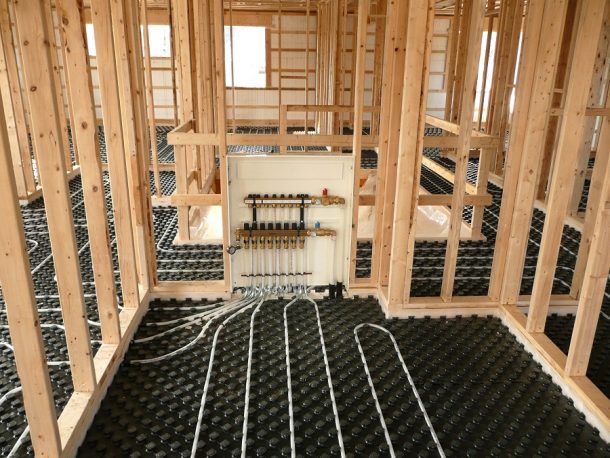 That said, with radiant floor heating, there’s a little more to learn. But, like fire sprinkler systems, starting with a proper design is key. If your design is wrong in the beginning, there’s not much you can do to fix the system once it’s installed.
That said, with radiant floor heating, there’s a little more to learn. But, like fire sprinkler systems, starting with a proper design is key. If your design is wrong in the beginning, there’s not much you can do to fix the system once it’s installed.
Take advantage of the radiant design services many PEX manufacturers offer to guide you through the process. There are several design factors to know, including floor R-values, heat-loss calculations, pipe sizing, loop lengths, pump sizing, manifold types and more.
Once you learn the basics of radiant design and get a few small jobs under your belt, you have the potential to take your expertise to the next level with bigger, more profitable projects. But again, be sure to get the proper design and training before you tackle a radiant project. It will be well worth it in the long run.
To get a jumpstart on all things radiant, visit the following industry websites at radiantprofessionalsalliance.org, healthyheating.com or heatinghelp.com.

Kim Bliss is the content development manager at Uponor. She can be reached at kim.bliss@uponor.com.
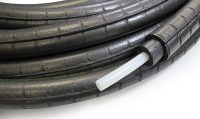
Eliminate the two-step process of insulation after installation to save time and labor costs with Uponor’s pre-insulated PEX pipe offering. With insulation thicknesses available up to 2″ to comply with ASHRAE Standard 90.1 and International Energy Conservation Code (IECC) requirements, the offering features Uponor AquaPEX® pipe for plumbing and Wirsbo hePEX™ oxygen-barrier pipe for hydronic Read more
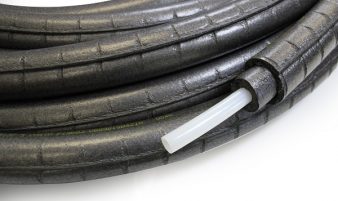 Eliminate the two-step process of insulation after installation to save time and labor costs with Uponor’s pre-insulated PEX pipe offering. With insulation thicknesses available up to 2″ to comply with ASHRAE Standard 90.1 and International Energy Conservation Code (IECC) requirements, the offering features Uponor AquaPEX® pipe for plumbing and Wirsbo hePEX™ oxygen-barrier pipe for hydronic heating and cooling applications.
Eliminate the two-step process of insulation after installation to save time and labor costs with Uponor’s pre-insulated PEX pipe offering. With insulation thicknesses available up to 2″ to comply with ASHRAE Standard 90.1 and International Energy Conservation Code (IECC) requirements, the offering features Uponor AquaPEX® pipe for plumbing and Wirsbo hePEX™ oxygen-barrier pipe for hydronic heating and cooling applications.
To learn more, visit uponorpro.com.
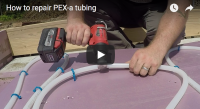
Cross-linked polyethylene (PEX) is manufactured using three different methods of cross-linking. PEX-A is produced by the peroxide (Engel) method. Common brands sold in North America produced under the Engel method would be Uponor, Rehau & MrPEX. One unique property of PEX-a is its ability to be heated, using a heat gun, and repaired if kinked Read more
Cross-linked polyethylene (PEX) is manufactured using three different methods of cross-linking. PEX-A is produced by the peroxide (Engel) method. Common brands sold in North America produced under the Engel method would be Uponor, Rehau & MrPEX.
One unique property of PEX-a is its ability to be heated, using a heat gun, and repaired if kinked in the handling process which eliminates the need to cut the tubing and install a coupling. This information is widely known by plumbers having experience with this type PEX but for those not familiar I thought I’d take a couple minutes and put it all in a quick video. The total time it took to make this simple repair was about 5 minutes using the cordless heat gun. I edited the video to speed up the process, using a corded heat gun would also quicken the process. No manufacturer condones the use of a flame (torch) as a heat source.
